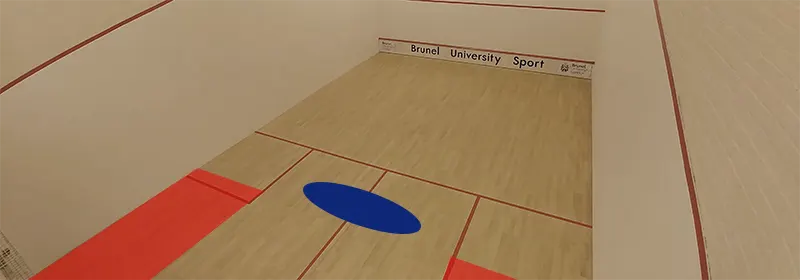04 July 2022 / 3-Min Read / Translate
To be able to reach your opponent’s shot quickly and effectively you need to position yourself in the right place. That’s on the join between the short line and half-court line, right? Wrong. I want you to think about the T being eqi-time distant from all corners, considering the direction you are facing and how long the ball would take to get there.

This is more or less when the T is, based on where the ball and opponent are.
To clarify, the T is not the exact centre of the court based purely on measurement i.e. half the distance from each side wall and half the distance from the front wall to the back wall. It’s the place where getting to the front corners and to the back corners in the time it would take the ball to get there. Let’s look at the three most common T positions and when you should be there.
One thing to mention before we look at these position, if you watch a professional squash match, you will almost certainly see them stand a little further forward than amateur players. That’s because they play more volleys than most amateurs because they have faster reactions. In addition, the exact position is partly related to your playing style, so a person how doesn’t volley very much might hang back more than a person who loves to volley. It’s an interesting question as to whether the T position defines the playing style or vice versa.
The red area is where you opponent is playing the ball from. You will notice that the blue area is an ellipse because it is okay to move slightly to the side that the ball is being played from.
Lastly, this is not an exact science, it’s just a guide and you must adapt the principles to suit the situation.

The T is slightly further back when the rallying is deep - for most players.
You would stand in this position if the ball and your opponent are in the back corners. You are closer to the back because even though the ball has to travel further to reach the back corners than the front, it takes less time to do so.
Therefore you need to be closer to the back. Any shot hit from the back to the front, say a boast or even a straight drop, will have to be hit softer and therefore takes longer to get there. Some players like to be slightly further back than the blue position show above because they can move forward much faster than they can move sideways and backwards.

Now the ball is further forward, so is the T.
In position two, you can see that it has moved forward. You should be here when your opponent is in front of you, but not right at the front. Perhaps you have hit a working boast and your opponent is making contact with the ball near the red area.
You need to be able to cover the back corners, but also be able to reach the front corners too. Essentially, the further forward the contact with the ball is, the further forward the T position is.

With the ball right at the front, the T moves further forward.
As you can clearly see, you are now quite far forward. You opponent might be playing a counter drop or a trickle boast, and while you do have to cover the back corners, the amount of time it takes for the ball to be hit within the red area and be played as a drop is not very much, therefore you need to be that little further forward.
Ideally, you would intercept any shot played to the back, which is why you should mostly hit very wide cross courts when you are at the front and want to hit to the back if you know your opponent is close to you.
The position you take is based on how fast you can reach each corner. You need to also take into account your movement speed and reaction time. Hopefully this article has given you some practical guidance about your position and I highly recommend becoming more aware of your position, but also your opponent’s position during rallies.
Moving quickly is only useful if you are moving in the right direction!